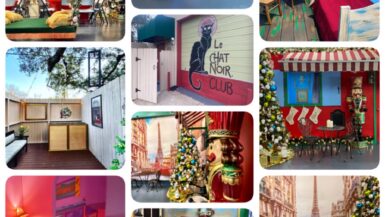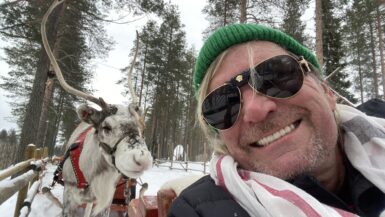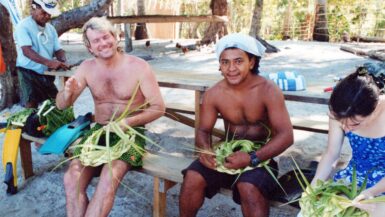I shielded my eyes from the pelting wind and tried to conjure up the album cover in my mind. How many naked babies were in the photo anyway? Led Zeppelin’s Houses of the Holy was released waaaaaay before Photoshop was invented so it was quite probable they were using real live hippie babies back then. It was the 70s and photographing unclothed babies climbing on weird rock formations apparently sold records. I’ll be honest. I loved that album and when I discovered that the cover was actually a real place called the Giant’s Causeway, I had to go to Northern Ireland and see it for myself. I was semi-relieved that the babies were no longer hanging out on the rocks nor living there as grown hippie adults. I love visiting places on album covers (as well as dead rockstars) and that’s what this piece is all about. There’s really no excuse for visiting England and not getting a picture of yourself walking across Abbey Road; No excuse at all. So sit back and let me tell you my list of ten famous places you should visit in the name of rock and roll.
A few years ago I was on a London train heading for the airport when I noticed a building that looked remarkably like the Pink Floyd Animals album I’d listened to countless times. That’s because it was. The closed down Battersea power plant has been a cultural icon for over 70 years as well as a shooting location for the Beatles “Help” video, Monty Python, Dr. Who, The Dark Knight, and even Alfred Hitchcock’s “Sabotage”. Although loads of artists such as Petula Clark,Judas Priest, Hanson, and One Direction have featured the building in their albums and videos, Pink Floyd gave it the iconic status it enjoys today. The plant can be reached by train just 18 minutes from Victoria station. If you’d like to add one more Floyd location to your list, the album Wish You Were Here was shot on the at Warner Bros. Studios in Los Angeles and can be visited by tram on a $65 tour that takes you to the spot where the two businessmen were photographed in 1975 shaking hands with one of them visibly on fire.
You might have noticed the tenement buildings behind Mick Jagger in the the Rolling Stones’ video “waiting for a friend” and thought they looked vaguely familiar. The address is 96 and 98 St. Marks Place, East Village, NYC. The building’s biggest claim to fame, however, is that it makes up the front cover for Led Zeppelin’s Physical Graffiti, which is considered by many to be the band’s greatest work. The property is still there and can be reached by taking the subway to 8th Street and walking a few blocks east. If you’re a “Zep head” and want more, don’t waste your time trying to find the marina from Presence or the bar from In Through The Out Door. Both sets were temporarily created and are no longer in existence: the first one at a boat show, the second in a studio. It was recreated from a photo of Old Absinthe Bar in New Orleans.
Hotel California by the Eagles is one of the most recognizable songs in the world. Although the recording is really about the pitfalls of the music business rather than a tourist stop, the photograph on the cover shows a scenic California style hotel at dawn or sunset. It turns out the hotel is none other than the famous Beverly Hills Hotel. Built in 1912 and frequented by movie stars and rock bands, the hotel is one of the most recognized places to stay in the world. If you love the song, you can always get a room and play it to your heart’s content. Located at Beverly Hills and Sunset Blvd, room rates start at around $650/night. For that price, they’d better have mirrors on the ceiling AND pink champagne on ice!
Abbey Road was just a regular section of the B507 road until the Beatles plastered it’s intersection on their eleventh studio album, thus changing the traffic forever. Almost 40 years later, fans still queue up to take their photos walking across the iconic “zebra crossing”. It’s easy to find the famous spot by taking the “tube” to St. John’s Wood and walking a block or two. Don’t expect the traffic to stop for you, though. The commuters aren’t nearly as excited about the intersection as you might be. This area is also the location for the famous Abbey Road studios which is a tourist landmark in its own right.
U2 spent 3 days driving around the Mojave desert shooting photos for what would become their 5th studio album. Bono had traveled in Ethiopia prior and had not only developed a love for the desert, but combined with his fascination with America, decided to take a road trip to the western United States. As the band shot picture after picture in Death Valley National Park and ghost towns, Bono learned a little about the legend of the Joshua tree and decided that should be the name of the yet untitled album. It might be difficult to line up the exact shot that appears on the cover of Joshua Tree (which ironically enough, has no Joshua trees in the photo) but it’s located at Zabriskie Point in Death Valley National Park. If you happen to be flying in or out of Paris, you can knock another U2 album off the list! The All You Can’t Leave Behind cover was shot in the departure lounge at Charles DeGaulle Airport.
In 1972 Ziggy Stardust, David Bowie’s alter ego (who had only a slightly cooler name than Bowie) shot his album cover The Rise and Fall of Ziggy Stardust and the Spiders from Mars at Hedden road in London. It’s a little side street near Piccadilly Circus. The album cover has a cartoonish appearance because it was shot in black and white and then colored by hand. If you’re looking for the exact same phone booth on the back cover of the record, you’ll have as much luck locating the TARDIS. The booth has been replaced twice and the original one’s whereabouts are uncertain. The side street has been referred to as the Bowie equivalent of The Beatles “Abbey Road” and you’re bound to find some fans posing in the same spot as Ziggy trying to recreate his iconic pose.
While you’re in the area, make your way to Berwick street in the heart of Soho. Oasis chose this street for their 1995 release of What’s the Story, Morning Glory? because of all the record stores in the area. The photo doesn’t feature images of the band members, but images of the record producer, sleeve designer and London DJ Sean Rowley.
There’s something immensely satisfying about visiting rock and roll historical sites and if you’re like me, once you get started, you probably won’t want to stop.
By the way, just in case you’re still wondering, there’s six naked babies.






Leave a reply
You must be logged in to post a comment.